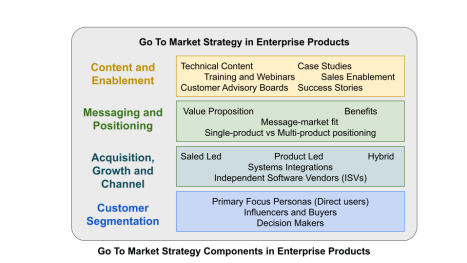This article delves into the distinct challenges and essential strategies for a successful Go-to-Market (GTM) approach within the enterprise domain. It initiates by unveiling the uniqueness of enterprise product management compared to regular product management, emphasizing the critical perspective of distribution as an inherent aspect of product processes. By highlighting the intricate buying journey in enterprises, involving diverse stakeholders beyond end-users, it delineates key components of GTM strategy in enterprise product management. Consequently, readers gain a robust framework and strategies to excel in enterprise product launches and cultivate valuable products.
The critical facets covered encompass customer segmentation to comprehend and address varied stakeholder needs, diverse account acquisition strategies (such as sales-led, product-led, and hybrid approaches), and the pivotal role of partners like Systems Integrators and Independent Software Vendors in expanding customer acquisition. Furthermore, it explores the significance of product packaging, positioning, messaging, and content creation in setting enterprise products apart in the market. Additionally, the article underscores the vital role of internal and external training, customer advisory boards, and generating content like case studies and best practice guides to bolster each phase of the customer lifecycle.
In summary, this comprehensive guide equips Enterprise Product Managers (EPMs) with the tools and insights to craft and execute effective GTM strategies, navigating the intricacies of enterprise-level product management and the diverse roles entwined within the enterprise buying process.
In the realm of product management, the landscape undergoes notable shifts when focusing on enterprise products. Leading these initiatives are Enterprise product managers (EPMs), professionals skilled in navigating the intricacies of defining products customized for expansive organizational requirements. Their responsibilities transcend conventional product management boundaries, requiring a sophisticated grasp of both the intricate needs of enterprise clientele and the strategic integration within the wider organizational framework.
Are these Enterprise product managers (EPM) any different than the regular product managers? Yes. While both share foundational principles, enterprise product management introduces distinct challenges, reshaping responsibilities and necessitating specific strategies for successful go-to-market approaches. Enterprise product managers specialize in customizing products for complex organizational workflows, such as Enterprise product managers systems like SAP or Oracle, focusing on scalability, security, regulatory compliance, and tailored integrations. Imagine building a healthcare application targeted for hospitals to collect payments from insurance companies, but failing to meet HIPAA compliance for handling healthcare data, or ensuring fintech compliance like AML rules or OFAC sanctions. Products need to proactively consider such requirements so they’re compliant from the ground-up, and it is not an afterthought. This contrasts with regular product ,anagers, who oversee consumer products like mobile apps, primarily catering to user needs and collaborating across product development, marketing, and sales to reach a broader audience.
In the consumer and prosumer realms, users usually come across new products through word-of-mouth, referrals, App Store recommendations, or platforms like Product Hunt. Once they find a product valuable, they typically act as the sole buyer or user. However, in the enterprise sphere, the process of discovery and purchase involves multiple interconnected stages, involving various teams or departments. While an employee might discover a new product independently, its adoption for team-based or company-wide usage requires navigating through several channels within the organization. This involves engaging with central IT for administrative, security, and compliance needs, finance for budget approvals, executives for strategic alignment, and sometimes dedicated procurement or purchasing teams. Reflect on your personal experiences, and consider the complexity involved when acquiring new software or implementing a product across teams or the entire company—how many steps or hurdles did you encounter in this process?
Therefore, enterprise product managers must comprehensively grasp the needs and motivations of not just end users but every individual involved in the buying journey. Each participant in this journey holds unique needs, preferences, and reasons to either endorse or decline the product. This underscores why overlooking distribution as an afterthought can result in product failure. Right from the inception of the product, managers must embed distribution into the product strategy, and MVP design, and plan for GTM and distribution activities from the outset. Distribution delineates the path for delivering products to users, guiding them from trial phases to becoming paying users. It ensures that intermediary teams and stakeholders perceive enough value in the product to facilitate its adoption and usage without obstruction. The best enterprise products meet the holistic needs of each persona in the buyer journey, so it feels like a seamless partnership and a win-win for everyone involved.
Enterprise product management demands a targeted approach when launching a product, beginning from the first interaction a prospect has with your product, be it a marketing page or documentation. These initial encounters shape impressions and opinions, eventually influencing trial and purchase decisions. Hence, a robust go-to-market strategy considers a 360-degree view of all touchpoints in the customer lifecycle, encompassing post-sale relationship management and upselling. The key components encompass:
Understanding and delineating ideal customer and buyer personas allows for a comprehensive grasp of each persona's distinct traits, demographics, behaviors, and habits. This knowledge provides a unified understanding across various functions like product, marketing, sales, and support. Identifying the needs and pain points of each segment helps in addressing gaps through product enhancement or tailored content. It also empowers sales teams with specific buyer details, facilitating more meaningful interactions and targeted leads while eliminating non-focus segments misaligned with the current strategy.
For example, let's say you're selling a project management software. You might have different types of customers, like small and medium businesses, large corporations, or even freelancers. Each group has different needs and preferences.
● Small businesses might care about affordability and ease of use.
● Large corporations might prioritize advanced features and integration capabilities.
● Freelancers might look for flexibility and mobility.
By understanding these differences, you can tailor your product and marketing to each group's specific needs. You might not even choose to target all these groups and focus on one single beachhead. This helps you focus your efforts where they'll have the most impact and avoid wasting resources on customers who aren't the right fit.
Three primary approaches—sales-led, product-led, and hybrid—steer account acquisition.
● Sales-led: Typically used for major deals like $100K+, relying on a sales-focused strategy with dedicated marketing efforts on select target accounts, also known as lighthouse customers.
● Product-led: Emphasizes self-serve or product-led purchases, capitalizing on digital transformation, allowing enterprises to buy software with limited sales intervention. It demands immediate value perception for users before signing up and often involves freemium or free trial options, aiming for scalable, low-touch sales.
● Hybrid: Blending self-serve for certain customer segments and a sales-led approach for others to ensure broader account coverage. Balancing pricing strategies to avoid cannibalization between these approaches is crucial.
● Scaling through partners: Systems Integrators (SIs) and Independent Software Vendors (ISVs) offer a potent avenue for scaling customer acquisition, especially for products requiring intricate integration cycles. SIs and ISVs simplify integration through abstraction layers and streamlined products, ensuring quick value delivery—a mutually beneficial arrangement benefiting customers, products, and vendors alike. It is common to bring in SIs and ISVs when your product needs additional customization for customers to be able to use it, creating monetization opportunities for service delivery.
For our project management software, large enterprises might need a sales representative for discovery through deals closing, while agencies and small businesses would likely self-serve purchases, as long as they see value in the product. SMBs also typically have a smaller ticket size, so having a white-glove sales approach may not be financially feasible.
Amidst a pool of products offering similar capabilities and addressing identical use cases within a category, the challenge emerges: Why should enterprises opt for your product over others? The answer often varies; it might be distinguished technology, a seamlessly
integrated platform, or superior price performance. When product managers handle a portfolio of products, the packaging, positioning, and messaging become pivotal. These elements can significantly impact the product's success or failure if not communicated clearly to customers and field teams.
Effective positioning elucidates the product's unique value across the portfolio and competitors, answering the question: "When is your product the ideal choice?" Your packaging and messaging, spanning from website content to sales pitches, determine your product's resonance with buyers. Therefore, experimentation and testing different variations before finalizing become crucial.
For our project management example, think back to when you were choosing between Monday.com, Asana, or Trello, what was most important for you? Was that captured in product benefits pages, or did you have to scour that feature in documentation pages?
The landscape of enterprise buying demands more than mere product demos or documentation. Savvy buyers seek implementation best practices, case studies, and domain thought leadership to drive successful conversions. This necessitates a proactive approach: product managers must ensure continuous internal and external training loops. Internal training equips sales, marketing, support, and solutions architects with comprehensive selling phases, competitive awareness, and necessary tools. Simultaneously, feedback loops ensure that received insights inform future planning. Externally, initial customers can amplify impact through reference architectures and case studies shared at industry conferences. Tailored content, such as best practice guides, migration assistants for technical practitioners, and pricing insights or competitive analysis for business stakeholders, supports various stages of conversations from lead generation to conversions. Additionally, engaging enterprise customers through advisory boards and councils fosters continuous feedback on strategic and tactical themes. This interaction, when appropriately established, becomes a mutually beneficial engagement where top customers influence roadmaps and product strategies.
For our project management software example, if you are targeting large corporations, they typically need to see evidence of success. You would thus need more than just demos. Provide guides, success stories, and expert advice. Train your team well to explain the product, and listen to customer feedback through advisory boards. This helps customers understand your product better and strengthens your relationship with them.

In this article, we've explored several strategies to navigate the intricate terrain of Enterprise Product Management, specifically focusing on the unique challenges and essential strategies for a successful Go-to-Market (GTM) approach in the enterprise domain. Our exploration covered the multifaceted nature of enterprise adoption, emphasizing the crucial understanding needed beyond end-users throughout the entire buying journey. We delved into vital GTM components, including customer segmentation, diverse account acquisition strategies, partner scaling, and the significance of packaging, positioning, and messaging for enterprise products. Ultimately, this article serves as a comprehensive guide, providing EPMs with powerful insights and tools to effectively design and execute GTM strategies, acknowledging the nuances of enterprise-level product management and the diverse roles intertwined within the enterprise purchasing process.
Explore more great product management content by exploring our Content A-Z








Comments
Join the community
Sign up for free to share your thoughts